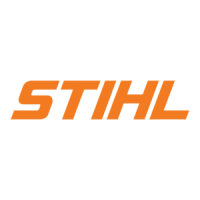BG 56, BG 56 C, BG 66, BG 86, BG 86 C, SH 56, SH 56 C, SH 86, SH 86 C
English
11
Watch out for small animals when
vacuuming and blow-sweeping in open
areas, yards and gardens.
To minimize blowing time, use a rake
and broom to loosen dirt particles before
you start blowing.
Recommended working technique to
minimize air pollution:
N If conditions are very dusty, dampen
the surfaces before starting work.
N Pull out the nozzle to full length so
that the airstream is at ground level.
N Do not blow particles in the direction
of bystanders, in particular in the
direction of children, pets, open
windows or freshly washed
vehicles. Blow the dirt particles
carefully to a central point.
N Put the dirt in garbage cans. Do not
blow it onto neighboring land.
Recommended working technique to
minimize noise:
N Operate your power tool at
reasonable times only – not early in
the morning, late at night or during
midday rest periods when people
could be disturbed. Keep to the
times prescribed locally. Normal
recommendation for professional
use on weekdays: 9:00hrs to
12:00hrs and 15:00hrs to 17:00hrs.
Be considerate towards neighbors
at weekends.
N Fewer engines mean less noise.
Where possible, do not run more
than one power tool at any time.
N Operate blowers at the lowest
engine speed necessary to
accomplish the task.
N Inspect your power tool before
starting work, especially the muffler,
air inlets and air filter.
Save water by using a blower instead of
a water hose for lawn and garden work
wherever possible, e.g. for cleaning
yards and patios.
Vacuuming abrasive material
(such as grit, stone chips, etc.)
causes the blower wheel and
blower housing to wear at a rapid
rate. This results in a considerable
loss of suction power. In such a
case you should contact your
dealer. STIHL recommends a
STIHL servicing dealer.
Take particular care when
vacuuming wet leaves since they
may block the blower wheel and
elbow.
Working Technique

